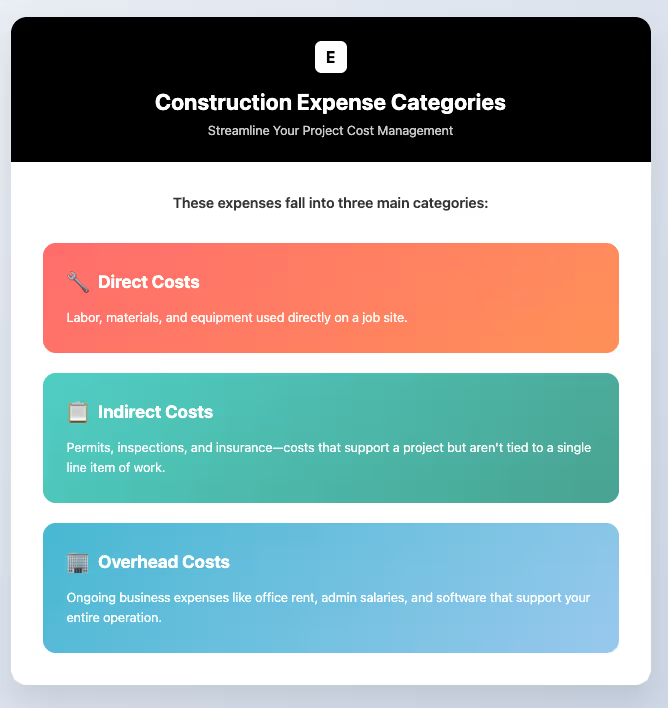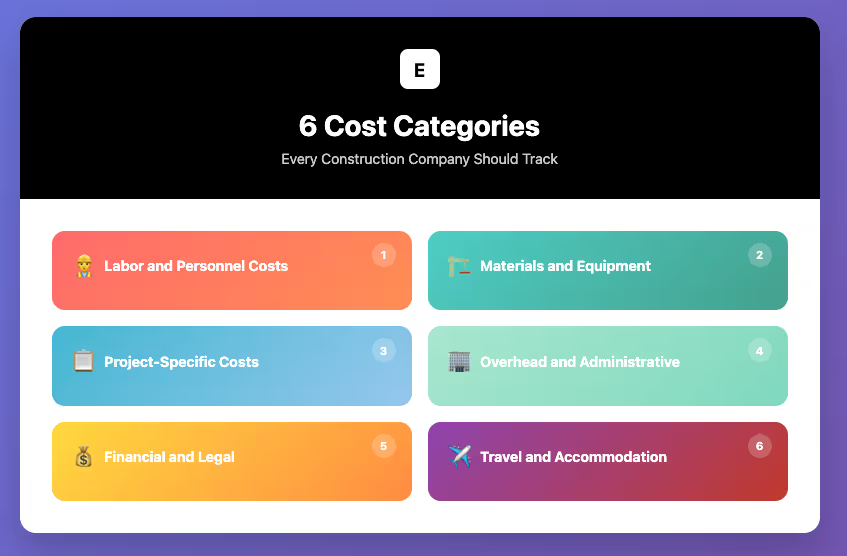Construction Company Expenses: A Complete Guide

You already juggle weather delays, permit holdups, and crews spread across three states. Margins are thin, so every dollar has to land exactly where you aimed.
Most of the big numbers are obvious—concrete, wages, crane rentals. But the cost that keeps slipping through the cracks is travel. Left unchecked, those trips drain cash and turn solid bids into money losers.
This guide breaks down the six core expense categories every construction company should track—then zooms in on travel. You’ll learn how to get it under control before it quietly wrecks your bottom line.
What are Construction Company Expenses
Construction company expenses include all the costs required to plan, manage, and complete a project—both in the field and in the back office. Unlike typical business expenses, construction costs are tied to specific jobs, shifting timelines, and decentralized crews.
These expenses fall into three main categories:
- Direct costs: Labor, materials, and equipment used directly on a job site.
- Indirect costs: Permits, inspections, and insurance—costs that support a project but aren’t tied to a single line item of work.
- Overhead costs: Ongoing business expenses like office rent, admin salaries, and software that support your entire operation.

Construction expenses work differently than regular business costs. Every dollar needs to get tagged to a specific job, which creates headaches when you're tracking costs across multiple active sites.
With shifting timelines, mobile crews, and added layer of compliance, costs pile up fast—and scatter even faster.
That’s why it’s key to organize your expenses into clear categories from the start. These six cost buckets help you track spend by job, catch overruns early, and keep your margins intact.
The 6 Cost Categories Every Construction Company Should Track
No matter how complex the project you manage is, every dollar should fall into one of the six essential buckets.

1. Labor and Personnel Costs
Labor is your biggest swing factor—according to ClockShark, in construction it accounts for 20% to 40% of the total job. When hours creep, profits vanish.
Your direct labor wages cover:
- Field crews
- Foremen
- Supervisors
But don't forget the hidden costs that follow every paycheck:
- Payroll taxes
- Benefits like Social Security, unemployment, health insurance, and retirement (adding another 20–30% on top of base wages)
Subcontractor payments deserve their own line item since specialty trades and independent contractors often represent half your labor costs, but they're the hardest to track and budget accurately.
2. Materials and Equipment
Raw materials and supplies form the backbone of every project. We estimate that materials often eat 30–40% of the budget, and equipment adds another 5–10%.
Concrete, steel, lumber, fasteners, and PPE costs swing wildly based on market conditions and supplier relationships. Smart contractors:
- Lock in pricing early
- Build escalation clauses into their contracts
Equipment costs split between rental and purchase. Heavy machinery, tools, and vehicles keep the job moving, but they also need:
- Fuel
- Repairs
- Maintenance
Factor in transportation costs to move equipment between sites.
3. Project-Specific Costs
Every site comes with its own red tape and prep work. Miss these and change orders pile up.
Permits and inspections vary by location and project type. Building fees, regulatory sign-offs, and compliance costs can surprise you if you're working in a new market.
Research local requirements before you bid.
Insurance premiums for general liability, workers' comp, and equipment coverage adjust based on project risk and location.
Site preparation and utilities cover the basics—clearing, temp power, fencing, and security—that get the job site ready for actual construction.
4. Overhead and Administrative
Overhead runs 5-15% of total cost. It's silent but deadly when you stop watching it.
Office operations include:
- Rent
- Utilities
- Supplies
- Admin salaries
These costs stay constant whether you're running one job or ten, so spreading them across more projects improves your margins.
Professional services like legal, accounting, engineering, and architecture consultants charge by the hour or project.
Technology and software for project management, accounting, and communication tools cost money but save time when chosen correctly.
5. Financial and Legal
Money costs money.
Financing gear or bonding a job keeps work moving but eats cash flow. Bonding and surety requirements include performance bonds, payment bonds, and bid bonds.
These protect owners but cost 1-3% of contract value. Interest and financing cover equipment loans, credit lines, and project financing that bridge the gap between work completion and payment.
6. Travel and Accommodation
Crews don't teleport. Travel can quietly run 5-15% of project spend, yet most shops still track it with spreadsheets. Crew transportation covers:
- Trucks
- Flights
- Rental cars
- Fuel
Lodging expenses for hotels and long-term housing become major costs on multi-week jobs, especially when you're working away from your home base.
Get these six buckets dialed in and you'll know exactly where to attack costs—as soon as they start leaking instead of after the job's closed.
Construction Travel Expenses: The Hidden Budget Killer and Real Costs
Getting concrete poured or steel set often means moving crews hundreds of miles from the shop. Travel isn't optional—it's built into the job.
The challenge? Most systems still treat those costs like an afterthought.
While corporate travel tools are built for one sales rep flying business class, your world looks different—18 carpenters who need rooms tonight because a storm pushed the schedule back two days.
Same category, completely different game.
Problems in Construction Travel Management
If you’ve had to organize crew travel, you already know the pain.
Crew transportation is the first headache. One week you're flying a project manager to a bid walk, the next you're shuttling a ten-person crew between two active sites. Every change means new bookings, cancellations, and rate changes.
Then comes the receipt circus. Independent contractors swipe personal cards for gas, meals, and last-minute hotel rooms. By the time you finally see those crumpled slips, the job has moved on and tracking which project pays for what becomes guesswork.
Timelines shift with weather, permits, or a late delivery. A two-night stay turns into a ten-day wait for an inspector. Corporate booking tools assume fixed schedules. Job sites don't work that way.
You're also spreading expenses across half a dozen active projects. One rental truck might serve three sites in the same week. Without project tagging at purchase, you spend hours splitting charges after the fact.
All of this piles onto whoever handles the books.
Chasing receipts, updating spreadsheets, and fielding "Where's my check?" calls drags you away from actual site work. Manual processing alone can triple the time it takes to close the books.
Real Financial and Operational Costs
These headaches don’t just annoy the back office—they bleed money in an industry where margins are razor-thin.
Gross margins may hover around 20%, but net profit margins often fall between just 2% and 10%, according to Bridget. In other words, there’s not much room for error.
When field coordinators spend two-plus hours a week reconciling accommodations instead of pushing the schedule, labor efficiency tanks. You're effectively paying project-rate wages for clerical work.
Contractors who front costs on personal cards wait weeks for reimbursement—hurting morale and retention. Direct billing solves this, but many companies haven’t adopted it.
Missing or late booking data means bids start blind. Underestimating hotel blocks on a multi-month job can erase your entire fee line. Finance teams can’t close the books without receipts, delaying billing, reporting, and lender updates.
Skilled labor is hard enough to find. Ask crews to chase reimbursements or stay in unapproved motels, and they’ll leave for a company with cleaner logistics.
Travel may start at 5–15% of project cost, but add change fees, unused bookings, and admin hours, and the real hit climbs. On a $5 million job, an extra 2% is $100,000—money that should’ve been profit.
Bottom line: if you don’t control logistics, they’ll eat your margin. How to fix it? Here are four proven ways to bring order to the chaos.
4 Best Practices for Construction Travel Expense Management
Good crew logistics isn't a spreadsheet problem—it's a job-site problem. When you fix it, cash flow gets easier, bids get sharper, and your crews stop chasing receipts.
- Centralized Booking and Payment Systems
Stop asking foremen to slap hotel charges on personal cards. Set up one system that books the room, pays the bill, and codes the charge to the right job number before anyone picks up a key.
Engine's Direct Bill feature works like this: crews check in without a credit card and the invoice lands in accounting already split by project. No reimbursements, no missing receipts, no crew members fronting thousands of dollars.
See how it works!
- Contractor and Subcontractor Management
Subcontractors roll on and off sites fast.
They're not downloading five apps or keeping paper receipts dry in the rain. Give them a mobile system where they snap a photo of the gas receipt, tag the job, and move on. Push approvals to managers' phones, even with spotty service.
Finance gets a digital trail; the field gets back to work.
- Project-Based Cost Control
If your expense tool can’t tag costs to specific jobs at the time of purchase, it's just another silo—one more export to clean up later.
Clean job coding upfront means every transaction lands where it should—no manual sorting, no guesswork later. Real-time visibility helps project managers spot budget drift early, before it turns into a margin killer.
- Technology Solutions for Construction-Specific Needs
Corporate booking apps assume one traveler, one ticket.
You juggle 20 electricians who may or may not pour concrete tomorrow depending on the weather. Platforms built for field work handle that chaos.
Engine is built for hotel bookings—designed around how crews actually travel. You can reserve group blocks that hold rooms until the last truck rolls in, add FlexPro to avoid losing money when timelines shift, and rebook or extend stays from your phone, mid-site.
See how it works!
Everything runs mobile, fast, and designed for schedules that move as much as the cranes. When the tech matches the work, logistics stops killing your margin and starts running like the rest of the job.
Construction Company Expenses: Manage All the Costs with Ease
Labor chews up 20–40% of every job, materials another 30–40%. You watch those lines like a hawk. Crew logistics quietly eats 5-15% of the budget yet gets zero scrutiny. On small margins, that blind spot decides whether a project makes money.
Fix crew spend, clear cash-flow jams, speed close-out, and feed bids with real numbers instead of guesswork. Pull last month's receipts to see where the money bleeds.
Sign up to Engine for free—one invoice, job-code tracking, no receipt chase.











.avif)









